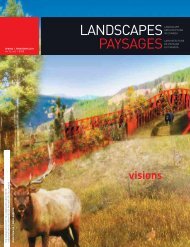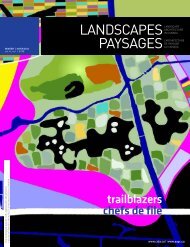time + place temps + lieu - CSLA :: AAPC
time + place temps + lieu - CSLA :: AAPC
time + place temps + lieu - CSLA :: AAPC
Create successful ePaper yourself
Turn your PDF publications into a flip-book with our unique Google optimized e-Paper software.
UPFRONT<br />
UPFRONT<br />
PROLOGUE<br />
HIBERNACULA TO CALL HOME<br />
EHA NAYLOR + PETER ANDREW-MCBRIDE<br />
The Windsor-Essex Parkway is at once an immense infrastructure project and one of the country’s largest<br />
ecological restoration sites. The new Parkway links Highway 401 to a new, badly needed Detroit River crossing:<br />
Windsor is Canada’s busiest border crossing. But since Essex Region communities have long borne the brunt of<br />
heavy traffic to the U.S. border, the Parkway was designed to be much more than a high-speed conduit. The<br />
11-kilometre freeway is largely below-grade and passes through 11 tunnels which carry the municipal road crossings<br />
and landscaped green space at their surface. An additional 120 hectares (300 acres) of green space, including 20<br />
kilometres of recreational trails, will allow cyclists, pedestrians – and wildlife – to travel the length of the Parkway<br />
without encountering vehicles.<br />
The ecological landscape work is extensive. Approximately 60 hectares of tallgrass prairie, oak savannah, oak<br />
hickory forest, woodlands, Pin Oak swamp, wetlands and fish habitat is being restored. For Species at Risk—be they<br />
plant or animal – relocation has been a key component. Already an unprecedented 125,000 at risk prairie plants<br />
have been relocated. Snakes are moving too, including two species at risk, the Eastern Foxsnake and Butler’s<br />
Gartersnake. Although only a fragment of their habitat will be impacted by construction, some 11 kilometres of<br />
temporary fencing has been installed to isolate snakes and other wildlife from the construction footprint and at the<br />
same <strong>time</strong>, salvage snakes found within the construction site.<br />
How exactly do herpetologists round up the snakes? Coverboards work: these are essentially large pieces of<br />
plywood where snakes like to bask or seek cover. Herpetologists check the boards daily to collect the snakes. Also,<br />
up to fourteen herpetologists and one specially trained sniffer dog actively search each site prior to commencing<br />
work. Thus far, herpetologists have collected over 1,000 endangered Butler’s Gartersnakes and several hundred<br />
Eastern Foxsnakes. Additionally, at least twenty snakes (and some<strong>time</strong>s double that number) are being tracked<br />
at any one <strong>time</strong>, leading to interesting discoveries. For example, Butler’s Gartersnakes are adopting crayfish<br />
burrows as hibernation sites. The snakes needs have been carefully considered. Brush piles and nesting/birthing<br />
sites are being re<strong>place</strong>d at a ratio of 3:1, as regulations specify. A key landscape feature of the restoration lands will<br />
be hibernacula. With <strong>time</strong>, the green space will evolve into a Parkway in a Prairie that offers tall grasses and oak<br />
savannah. It will support Butler Gartersnake and Eastern Foxsnake throughout their life-cycle.<br />
Eha Naylor, a partner with Dillon Consulting Limited, says that herpetologist Peter Andrew-McBride was so engaging<br />
that he became “an honorary landscape architect for an evening, when he was called into service at a community meeting.”<br />
ENaylor@dillon.ca www.dillon.ca<br />
GOLF ARCHAEOLOGY AT HIGHLAND LINKS:<br />
IAN ANDREW<br />
http://ianandrewsgolfdesignblog.blogspot.ca/<br />
Golf restoration can occasionally become an archeological dig. This can happen when you are working<br />
with a course where the original features are gone, and you lack the information you need for restoration. Very<br />
recently, I was working on the restoration of the back bunker of the 8 th hole at Highlands Links, which was<br />
designed by Stanley Thompson in 1939. (Stanley called it “the mountains and ocean” course.) This was one of the<br />
few bunkers that did not show up on historical images or aerials. I was completely perplexed by the hollow where<br />
the bunker was “thought to be” since it did not make architectural sense. After much deliberation I suggested<br />
the hollow could not be that location. Instead, we began our work closer to the green where Stanley Thompson<br />
would have been far likelier to have <strong>place</strong>d it. I needed to clean up this area anyway and this allowed a peek into<br />
what lay below. While digging out the area we discovered coarse sand: it was certainly original and indicated<br />
that the bunker had in fact been much closer to the green than most people thought. By the <strong>time</strong> we were done<br />
excavating we knew the shape, depth and location of the original bunker. When the restoration was finished, the<br />
oldest member of the club came by and said that’s exactly how he remembered it.<br />
READ MORE about the fascinating business of golf course restoration on page 24.<br />
14 LANDSCAPES PAYSAGES






